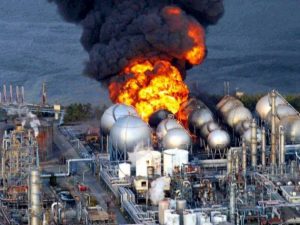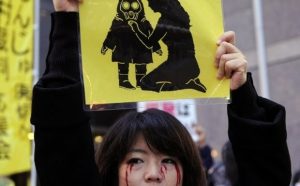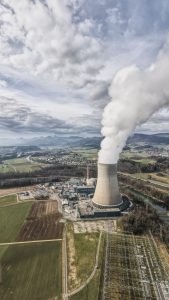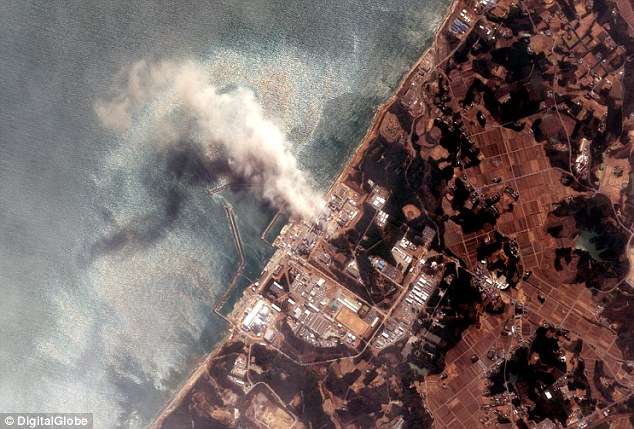On March 11, 2011 at 2:46PM local time, a magnitude 9.0 earthquake hit Japan. It was such a powerful catastrophe, that Japan’s main island, Honshu, was permanently moved more than two meters to the east. As the earthquake gained momentum, wave runups of up to 40 meters began crushing the country’s coast. The effects of the earthquake and the waves were too much for the Japanese. More than 20,000 people died or went missing, and hundreds of thousands more lost their homes. After the initial catastrophe, a series of accidents and disasters continued during the following days putting even more lives at risk. Fifty minutes after the initial earthquake, a 14-meter tsunami hit the Fukushima Daiichi (Number One) nuclear power plant. The water from the large wave flooded the plant’s emergency power generators, knocking out vital cooling systems to the six nuclear reactors at the power plant, and triggering a meltdown of reactor fuel rods. With the cooling systems offline, hydrogen gas built up in the reactor buildings, causing several hydrogen explosions in the days following the earthquake. The damaged reactors then inexorably leaked radiation into the environment of coastal Japan.1 More than 10 years have passed since the Fukushima disaster but the fear still lingers. Today, nuclear power’s reputation as a safe energy source has been damaged, despite the work of scientists, engineers, and organizations around the world who have made important advancements to this power source to make it more efficient and trustworthy.

After the original tsunami, efforts were made to quickly fix the issues that resulted from the nuclear disaster. Japan’s then-Prime Minister, Naoto Kan, met with TEPCO (Tokyo Electric and Power Company) officials, creating the Integrated Response Center at the TEPCO headquarters near the explosions, and coordinating the evacuation of over 100,000 residents living within a 12-mile radius of the stricken power plant. 2 The response seemed bureaucratic, but it was necessary to coordinate the citizens and the various organizations that were part of the emergency response effort. Despite these efforts, it was became evident that there would be challenges in keeping the environment clean from any nuclear radiation, as part of the emergency response included the venting of gases to reduce the pressure in the reactor containment systems at the power plant. These actions incited local and global protests to protect the remaining citizens living near the power plants. As part of the comprehensive solution and to answer to these protests, the Japanese government issued a report on the various events that followed the March 11 earthquake. The report also highlighted the mistakes made by TEPCO officials that led to unsafe measures and global safety standards. 3

The Fukushima disaster was classified as a level seven catastrophe (the highest level of the International Nuclear and Radiological Event Scale) for several reasons. About 20,000 people died as a direct result of the earthquake, hydrogen fires, and exposure to large amounts of radiation. While there have been other nuclear catastrophes before, such as the Chernobyl (1986) and the Three Mile Island (1979) incidents, the Fukushima disaster has been the second-largest disaster (after Chernobyl), and it is the deadliest and the most recent one. Additionally, the company in charge of the Fukushima nuclear plants, TEPCO, assured the Japanese that the facilities were “fail-safe”. However, the company overlooked several aspects of the facilities, that since their construction and commissioning in 1971, made them more vulnerable.
The people did not trust TEPCO anymore, and the fear that is common after environmental catastrophes re-surged after the disaster, changing how the Japanese viewed this power source. Before the Fukushima disaster, 30 percent of Japan’s energy needs were provided through nuclear energy, with plans of increasing it to 50 percent by 2030 to keep up with Japan’s energy demands while at the same time reducing the nation’s carbon footprint. However, in less than two years, most of the power plants in Japan were closed down or paused temporarily for inspection and risk assessment 4 After efforts to ensure the safety and maintenance of the plants were completed, 44 reactors resumed operations, providing about 22 percent of Japan’s energy needs. However, the number of active reactors did not sit well with the Japanese people, and the population at large was against this policy. Because of public disapproval, as of 2018, only three nuclear power plants continuing to generate electricity in Japan. 5
Because of the large amount of radioactive contamination released from the catastrophe, the direct costs of the accident are staggering. According to the Natural Resources Defense Council, the total cost is likely to exceed $200 billion for cleanup and recovery, a process that will most likely take decades.6 However, recent research by environmental radiologist Thomas Johnson at Colorado State University says that the levels of radiation have decreased dramatically and in fact, other areas of the world have higher radiation levels than those found near the Fukushima plant. 7 There are still highly contaminated areas, however, including a valley north from the Fukushima plant, as the wind was blowing toward the northwest while the meltdown was occurring. 8

of Patrick Federi
The Fukushima Disaster made the world more aware of the challenges associated with nuclear power, prompting policy changes around the world. While each nation’s reaction was different, depending on their view of nuclear power, anti-nuclear lobbying similar to Japan’s increased. For example, Germany and Switzerland announced that they would phase out their nuclear power plants after facing protests and public pressure. Venezuela cancelled their plans to build a nuclear power station, and other nations such as Australia, Denmark, Portugal, Norway, and Spain, joined the list of countries with anti-nuclear power movements. 9 On the other hand, despite vigorous debates on the role of nuclear energy, nations such as France, the United States, Russia, and the United Kingdom continued to rely on nuclear power as an energy source. Planning of nuclear power stations in developing countries were also unaffected, however, the lack of trained technicians that are able to implement this energy source is keeping these nations from moving forward with plans to build nuclear power stations. 10
The Fukushima disaster changed many aspects of how we plan and manage nuclear energy, as well as our views of this energy source. Additionally, the accident reminded people of the need for correct management of energy production, and the overall effects that inadequate planning and controls can have on humans and the environment. Nuclear power is an important energy source that affects economics, politics, and culture, and the Fukushima disaster is a clear example of how energy’s interconnectedness with our lives goes beyond powering our day to day activities. The reality is that the world continues to rely heavily on nuclear power, and it is more important than ever for nations to learn from mistakes and continue to work on making nuclear energy both safer and more reliable.
- Learn, Joshua. “How Long Will Fukushima Stay Radioactive?” Discover Magazine, February 4, 2022. https://www.discovermagazine.com/environment/how-long-will-fukushima-stay-radioactive ↵
- Kan, Naoto, and Brett de Bary. 2018. The Fukushima Nuclear Power Plant Disaster and the Future of Renewable Energy. Mario Einaudi Center for International Studies Distinguished Speaker Series. Cornell University Press. ↵
- Encyclopedia Britannica, 2018, s.v. “Fukushima Accident.” ↵
- Kan, Naoto, and Brett de Bary. 2018. The Fukushima Nuclear Power Plant Disaster and the Future of Renewable Energy. Mario Einaudi Center for International Studies Distinguished Speaker Series. Cornell University Press. ↵
- Kan, Naoto, and Brett de Bary. 2018. The Fukushima Nuclear Power Plant Disaster and the Future of Renewable Energy. Mario Einaudi Center for International Studies Distinguished Speaker Series. Cornell University Press. ↵
- Ghosh, Padmaparna. “Nuclear Power 101.” NRDC, May 4, 2022. https://www.nrdc.org/stories/nuclear-power-101. ↵
- Learn, Joshua. “How Long Will Fukushima Stay Radioactive?” Discover Magazine, May 4, 2022. https://www.discovermagazine.com/environment/how-long-will-fukushima-stay-radioactive. ↵
- Learn, Joshua. “How Long Will Fukushima Stay Radioactive?” Discover Magazine, May 4, 2022. https://www.discovermagazine.com/environment/how-long-will-fukushima-stay-radioactive. ↵
- Milošević, Zoran, Miroslav Vesković, Milivoj B. Gavrilov, Tin Lukić, and Slobodan B. Marković. 2013. “Using Natural Disasters to Instigate Radical Policy Changes – the Effect of Fukushima Nuclear Power Plant Accident on Nuclear Energy Policies.” Acta Geographica Slovenica 53 (1):186. doi:10.3986/AGS53303. ↵
- Milošević, Zoran, Miroslav Vesković, Milivoj B. Gavrilov, Tin Lukić, and Slobodan B. Marković. 2013. “Using Natural Disasters to Instigate Radical Policy Changes – the Effect of Fukushima Nuclear Power Plant Accident on Nuclear Energy Policies.” Acta Geographica Slovenica 53 (1):186. doi:10.3986/AGS53303. ↵




21 comments
Dylan Vargas
I really like this article, it gives us the problem and then it shows the effects after the earthquake and what happened after the powerplant explosions. The tsunami causing the power plant to explode and the earthquake of course but it also showed the effects of the powerplant and then the people’s distrusted of the company TEPCO to cause protests. Also explaining the plans they have which was to make Japan’s electricity 50% reliable on the power plants to just 3 left in Japan. Also giving examples of how different countries reacted to the incident that occurred or how they would react. It goes into depth and I like how it does it.
Rodney Jones
Wow, this article amazed me your writing didn’t seem at all biased and gave out some valid facts about what happened during this disaster. I enjoyed reading about how it affected people around the world and how we are way more careful with Nuclear power because of this disaster. I also didn’t even know that it cost 200 billion dollars that is insane.
Courtney Mcclellan
The explanation of what happened with the plant was really interesting and informative. It was a big insight to know that Japan has shut down many of its power plants because of the public instead of by their own accord. It was nice to learn about the reaction of other countries planning to use nuclear energy since so many stopped their plans to begin their nuclear plants.
Sudura Zakir
Tokyo is one of the topmost developed city in the world. Spending a single day here is like living in the future in 2022. Technology has
made this awesome change and they are working hard to get much better in the future days. Fukushima disaster was much painful but now they are progressing more.
Ben Kruck
I actually didn’t know this happened, so this is my first-time hearing about it. This is a very interesting article, it goes into a lot of detail, and helps remind us that while nuclear energy can be helpful, they are extremely dangerous as well. This is an event that clearly shook the world and definitely changed how people can see nuclear power plants.
Abigail Delarosa
I have always been interested in topics like these. I remember watching a documentary on Netflix about the bombing of Hiroshima and how the nuclear rays affected people. Its crazy how bad it affects people and they can’t do nothing about it. It was sad reading how all those people especially kids effected by the radiation. To kill over 20,000 people is a number I can’t wrap my head around. I really enjoyed reading this article I didn’t get bored once I will for sure read more of your articles in the future.
Abigail Delarosa
I have always been interested in topics like these. I remember watching a documentary on Netflix about the bombing of Hiroshima and how the nuclear rays affected people. Its crazy how bad it affects people and they can’t do nothing about it. It was sad reading how all those people especially kids effected by the radiation. To kill over 20,000 people is a number I can’t wrap my head around. I really enjoyed reading this article I didn’t get bored once I will for sure read more of your articles in the future.
Dylan Damian
The response to the emergency is the one of the most fascinating parts of this situation to me. Not only is this entire event caused by an already devastating earthquake, but it then becomes elevated through the nuclear power plant making things infinitely worse via radiation and chemicals. And seeing how the emergency responders tried to come up with solutions to deal with the immediate threat.
Jordan Davenport
This is a very detailed and informative explanation of the course of events, tragic results, and global reactions during and after the Fukushima nuclear power plant disaster. From the start of the article, it was explained that an earthquake caused massive flooding which led to the power plant to have major complications, and it was not the power plant failing on its own, there were many different factors that caused this terrible event, some uncontrollable such as the earthquake, but also some preventable measures that TEPCO officials failed to address, and through TEPCO’s mistakes has caused distrust and fear over nuclear energy, which was explained in this article.
Enrico Zorzin Onzi
In fact, the natural catastrophes that hit Japan on March 11 shocked the entire world. I was in Brazil this day, and I remember watching the news about the disaster. In addition, this was the news for a whole week. Unfortunately, the Fukushima disaster will always be in the history, but I cannot understand how TEPCO assured that the construction was “fail-safe” and it just exploded after a natural catastrophe killing several innocent people. I did not know that this tragedy made other countries step back about building or generating nuclear energy sources. In my opinion, it can be an alternative source of energy, but at the same time, the knowledge about nuclear energy is not completely dominated by scientists. Also, nuclear energy should be perfectly managed, no mistakes and I hope that a disaster like Fukushima never happens again. I really enjoyed reading this article.